25 Digestion-related anatomy
Monogastrics (carnivores, omnivores)
Anatomy
As described in the chapter on Normal Digestion, food follows a fairly straightforward and relatively short path in a simple stomached (monogastric) animal,
-
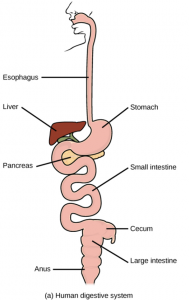
Simple stomached animals have GI tracts that closely resemble human ones
https://upload.wikimedia.org/wikipedia/commons/7/7a/Figure_34_01_05ab.jpgoral cavity – food is chewed up to increase surface area and may/may not be mixed with salivary enzymes
- esophagus – food moves quickly down the esophagus and through the distal esophageal sphincter
- stomach – holds and grinds food, mixing it with hydrochloric acid and pepsin
- small intestine – the major area of digestion and absorption as food is mixed with bile and pancreatic enzymes and broken down into component parts
- large intestine- more water resorption and home of some bacteria that further aid in production of essential vitamins
- rectum – holding area until the animal has time to defecate
Pigs do have a spiral colon that is an expanded large intestine (LI) to enable some cellulose digestion.
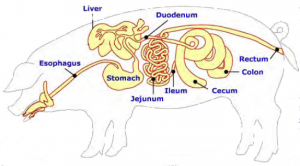
Digestion overview
In general, carbohydrates (nonstructural) get digested into glucose in the small intestine, proteins into amino acids in the stomach and small intestine, and fats into lipids in the small intestine.
The pancreas is essential for digestion and gut health (enzymes, antibacterial protein, intrinsic factor, sodium bicarbonate), as is the liver. Besides producing the bile needed for fat digestion, the liver gets all of the blood from the gi tract and further processes the nutrients before sending on a balanced “ration” to the rest of the body.
Impacts of the kidney and brain
Other organs are also involved less directly in metabolism:
Kidneys regulate fluids, electrolytes and proteins. Kidney dysfunction can mimic GI disorders. With kidney damage, animals can develop proteinuria (high levels of protein in the urine due to protein loss through the kidneys). This can look like poor digestion or poor absorption of proteins.
The brain can impact GI function in both good and bad ways. The brain responds to the sights and sounds of food, starting and enhancing the process of digestion. The brain can moderate motility and does this as part of the flight/fight response (aka rest and digest) as well as in periods of stress. The vomiting center is in the brain and is involved in all types of nausea and vomiting including vomiting due to motion sickness, drug responses and intestinal foreign bodies.
Hence, availability and usage of nutrients can be impacted by the GI tract, the liver, the pancreas, the kidney and the brain.
Herbivores
Major variations of the GI tract occur in animals that eat grasses and hays. Very few herbivores have exactly the same set of modifications but all are similar in that they have a fermentation area where bacteria do the work of structural carbohydrate digestion.
Horses
Horses are grazing animals. They have a relatively small stomach for their size. They eat small amounts almost constantly rather than a large meal once a day or every few days.
Grasses are not easy to digest. Hence the modification of the colon and cecum. Besides expanding the length of the colon, motility is also adjusted to allow backwards and forwards ingesta flow, extending the time the grasses spend in the colon.
Horses do not have a gall bladder. They have a biliary system but, instead of collecting in a gall bladder, bile is just constantly emptying in to the small intestine.
Horses are often fed corn, oats, and/or barley as well as sugar beet pulp, fat supplements and proteins. These compounds (corn, oats, barley etc) are basically the same nonstructural carbohydrates, fats and proteins that we feed to monogastrics. As a monogastric, think about your morning cereal!
Horses also eat grasses and hays. The grasses and hays are known as structural carbohydrates. Cellulose envelopes the useful (nonstructural) carbohydrate in the structural carbohydrates. Animals don’t have cellulase so really can’t digest cellulose and can’t get to the sugars underneath. Bacteria are needed to perform this function; they do have the enzyme cellulase. The greatly enlarged ascending colon and cecum in the horse are fermentation chambers for the digestion of these structural carbohydrates.
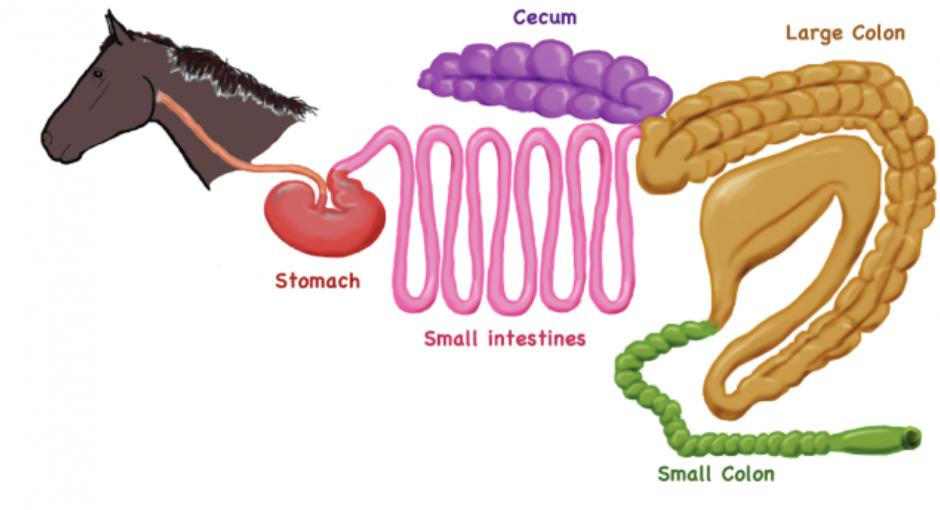
Cattle
Cattle (and sheep and goats) digest grasses in the forestomach or rumen. The forestomach is positioned between the esophagus and the main stomach (abomasum). The forestomach has 3 parts:
- rumen – large fermentation vat; the inner surface is covered by papilla
- reticulum – sorts particles into those that need more digestion or are ready to be moved down the GIT; honeycomb inner surface
- omasum- in charge of fluid removal; full of “leaves” that enhance water and nutrient absorption
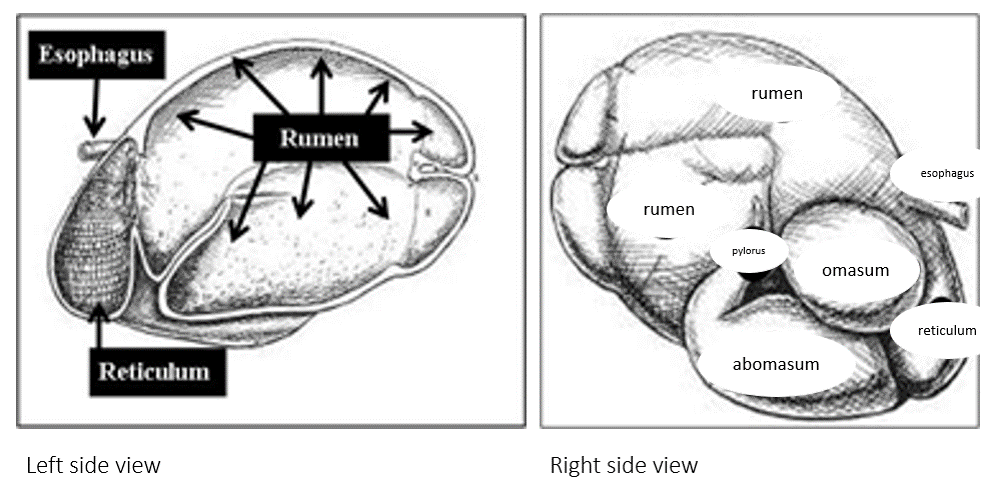
The abomasum is a true stomach with gastric acid producing structures, etc.
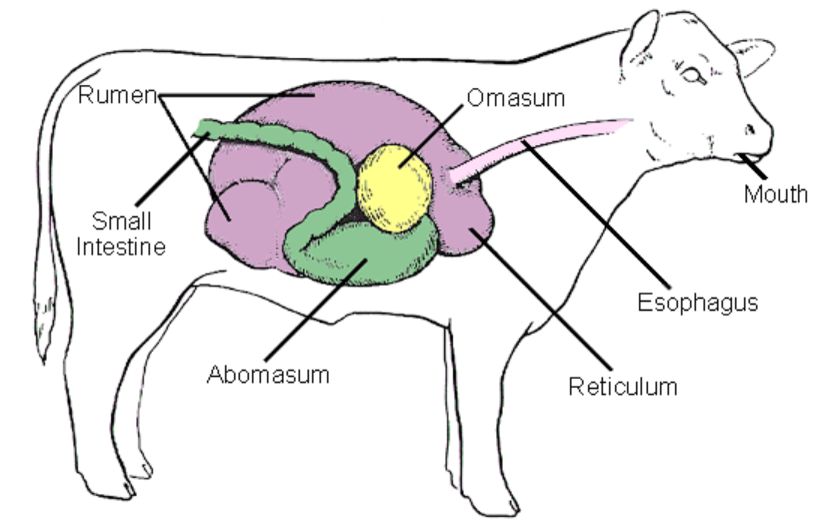
Ruminants can regurgitate (eructate) and rechew the grasses. This is called chewing their cud. This process allows further digestion of those tough grasses and hays.
Cows do have a spiral colon, similar to that of pigs. They also have an elongated cecum, similar to that of horses. These structures will also help digest cellulose products.
Camelids
Camelids are pretty similar to cattle in that they have a forestomach and chew their cud. They have 3 versus 4 stomach chambers.
- C1 – like a rumen
- C2- like a reticulum
- C3- true stomach; also does water absorption somewhat like an omasum
Camelids also have a very tightly coiled spiral colon.
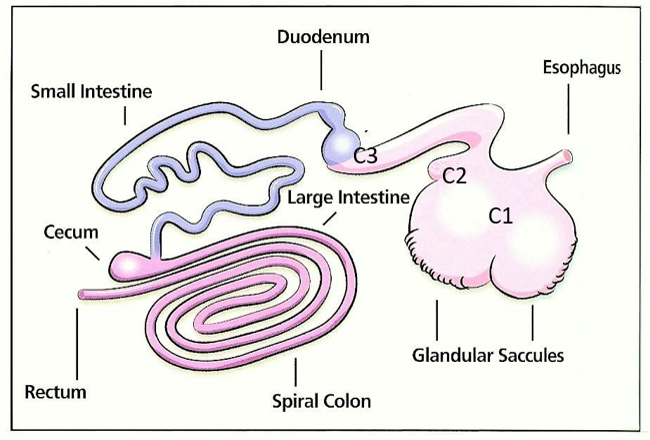
Note: horses do not vomit ( they have a very strong distal esophageal sphincter) and ruminants rarely vomit. For animals with forestomachs, vomiting from the stomach pushes fluid back into the forestomach versus out the mouth.
Teeth
Teeth match the diet.

Brachydont species
- dogs and cats
- teeth designed for ripping and tearing
- short roots
Hypsodont species
- horses, ruminants
- teeth designed for grinding
- long roots because actually grind teeth down
- cattle and camelids have an upper dental pad rather than upper incisors
Key Takeaways
Key components
- Protein digestion starts in the stomach and continues in the small intestine, while carbohydrates and fats are mostly digested in the small intestine by pancreatic enzymes
- Proteins, non-structural carbohydrates and fats are digested in herbivores the same way they are in carnivores and omnivores. Dead bacteria are a protein source in animals with forestomachs.
- Pancreatic enzymes are required for digestion
- The liver is essential for digestion of fats and balances nutrients for the rest of the body
- Herbivores need microbial digestion and more time to further digest structural carbohydrates (fiber, hay). Ruminants and camelids regurgitate to further chew food.
- Herbivore microbes live in the fermentation section of the GI tract – this can be the forestomach such as cattle and camelids, or the hindgut such as in horses and rabbits.
- Bacteria produce volatile fatty acids (energy source) and B vitamins for the host.
- Dysfunction of the liver, kidney, pancreas, and brain often produce changes in nutrient usage. Microbial health is also necessary for good digestion.

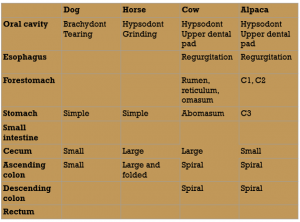
Video Resources
How your digestive system works – confused from the beginning? start here to just get a nice overview
A cow’s digestive system – good review and intro to physical exams
Ruminant structure and function – nice overview
More ruminant videos
Equine GI tract– review of anatomy
Rabbit coprophagy – excellent video
Digestive system part I crash course – the path of nachos from start to finish; longer but worth watching a few times; it is jam packed with relevant info
Comparative anatomy slide show
Digestive system overview and comparison – CSU web pages

